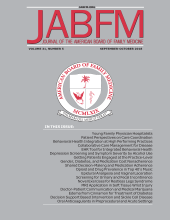Article Figures & Data
Tables
- Table 1. Opioid Prescribing Practices of 623 Primary Care Physician and Advanced Registered Nurse Practitioner (ARNP) Survey Respondents, Overall and by Physician, ARNPs, and Two Large Practice Site Subgroups*
Overall (623) Physicians ARNPs Spokane Group Health Prescribes opioids to ≥50% of patients with CNCP 186/610 (30.5) 113/284 (39.8) 52/240 (21.7) 25/75 (33.3) 9/48 (18.8) Now prescribes opioids to: More CNCP patients 63/601 (10.5) 29/284 (10.2) 27/240 (11.3) 3/73 (4.1) 2/48 (4.2) Fewer CNCP patients 267/601 (44.4) 129/284 (45.4) 103/240 (42.9) 46/73 (63.0) 29/48 (60.4) Stopped prescribing 20/601 (3.3) 6/284 (2.1) 14/240 (5.8) 2/73 (2.7) 0/48 (0) Now prescribes: Higher doses more often 34/594 (5.7) 17/282 (6.0) 12/238 (5.0) 1/73 (1.4) 1/47 (2.1) Higher doses less often 277/594 (46.6) 142/282 (50.4) 97/238 (40.8) 43/73 (58.9) 27/47 (57.4) No Change 262/594 (44.1) 117/282 (41.5) 116/238 (48.7) 26/73 (35.6) 18/47 (38.3) When prescribing opioids, how concerned are you about (% very concerned): Overdose or addiction or dependence or diversion 425/588 (72.3) 207/283 (73.1) 169/236 (71.6) 56/73 (76.7) 29/47 (61.7) Regulatory scrutiny 149/588 (25.3) 79/283 (27.9) 54/235 (23.0) 21/72 (29.2) 6/47(12.8) Values are n/N (%).
↵* There were 623 respondents who said that they treated patients with chronic noncancer pain (CNCP), but the sample size for each question differed because of missing data and skip patterns. The physician, ARNP, Spokane, and Group Health categories are subgroups of the overall group and may overlap.
Overall (n = 623) Physicians ARNPs Spokane Group Health Read and/or applied guideline 309/562 (55) 200/282 (70.9) 95/237 (40.1) 33/65 (50.8) 27/45 (60.0) Yellow flag dose (120 mg/day morphine equivalents) reasonable or too high 489/561 (87.2) 241/283 (85.2) 211/237 (89.0) 58/65 (89.2) 42/46 (91.3) Tools available in clinic Policy, guideline, or algorithm for prescribing opioids for CNCP 344/592 (58.1) 194/285 (68.1) 116/239 (48.5) 39/72 (54.2) 42/47 (89.4) Electronic prescription record linked to EMR 440/590 (74.6) 238/283 (84.1) 150/240 (62.5) 57/71 (80.3) 45/46 (97.8) Of those who tried to obtain a pain management consultation, percentage never or almost never successful 64/408 (15.7) 34/219 (15.5) 29/175 (16.6) 17/40 (42.5) 1/30 (3.3) How helpful would you find each of the following in managing your patients with CNCP? (% somewhat or very helpful) Telephone consultation with experts 445/532 (83.6) 219/282 (77.7) 212/234 (90.6) 49/61 (80.3) 39/44 (88.6) Telemedicine or web-based tool 360/532 (67.7) 169/281 (60.1) 178/235 (75.7) 44/61 (72.1) 28/43 (65.1) Web-based CME training 466/531 (87.8) 234/279 (83.9) 218/235 (92.8) 49/61 (80.3) 40/43 (93.0) Patient decision aids 468/533 (87.8) 240/280 (85.7) 213/237 (89.9) 54/60 (90.0) 37/43 (86.0) Advanced training that would provide a certificate of special competence in treatment of CNCP 420/531 (79.1) 195/278 (70.1) 209/236 (88.6) 41/60 (68.3) 34/43 (79.1) Prescription monitoring program 479/534 (89.7) 255/280 (91.1) 207/237 (87.3) 57/61 (93.4) 42/44 (95.5) Collaborative drug therapy agreement with pharmacists to prescribe or manage patients taking opioids (% yes) 95/539 (17.6) 96/284 (33.8) 37/238 (15.5) 8/62 (12.9) 21/44 (47.7) Values are n/N (%).
↵* There were 623 respondents who said that they treated patients with chronic noncancer pain (CNCP), but the sample size for each question differed because of missing data and skip patterns. The physician, advanced registered nurse practitioner (ARNP), Spokane, and Group Health categories are subgroups of the overall group and may overlap.
CME, continuing medical education; EMR, electronic medical record; Q24f.







